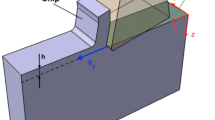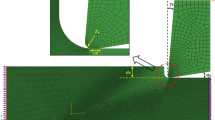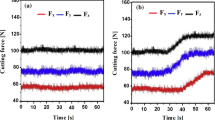Abstract
Ti-6Al-4V alloy is known as a typical difficult-to-machine hard material due to its inherent properties such as low thermal conductivity, low elastic modulus, and high reactivity with cutting tool materials. This paper proposes a two-dimensional coupled thermo-mechanical model of plane strain orthogonal cutting for Ti-6Al-4V alloy deformation near the exit edge. Johnson–Cook material constitutive model and Cockroft–Latham damage criterion are utilized in the model for better understanding the plastic behavior and chips formation during the cutting process. The machining parameters such as cutting speed, tool edge radius, rake angle, and cutting depth are taken into account in the simulation. The results show that an edge defect generates at the exit edge after machining. The edge defect consists of two fracture surfaces, namely, the first fracture surface of opening-mode crack and the second fracture surface of sliding-mode crack. Besides, the edge defect sizes are greatly sensitive to machining parameters. This study provides a better understanding of burr/breakout formation mechanism near the exit surface and optimization of machining parameters in cutting Ti-6Al-4V alloy.
Similar content being viewed by others
References
Gillespie LK, Blotter PT (1976) The formation and properties of machining burrs. J Manuf Sci E-T ASME 98:66–74
Aurich JC, Dornfeld D, Arrazola PJ (2009) Burrs—analysis, control and removal. CIRP Ann-Manuf Techn 58:519–542
Ko SL, Dornfeld DA (1991) A study on burr formation mechanism. J Eng Mater-T ASME 113:75–87
Sung-Lim K, Dornfeld DA (1996) Analysis of fracture in burr formation at the exit stage of metal cutting. J Mater Process Tech 58:189–200
Ko SL, Dornfeld DA (1996) Burr formation and fracture in oblique cutting. J Mater Process Tech 62:24–36
Chern GL, Dornfeld DA (1996) Burr/breakout model development and experimental verification. J Eng Mater-T ASME 118:201–206
Toropov A, Ko SL (2006) A model of burr formation in the feed direction in turning. Int J Mach Tool Manu 46:1913–1920
Toropov AA, Ko SL, Lee JM (2006) A new burr formation model for orthogonal cutting of ductile materials. CIRP Ann-Manuf Tech 55:55–58
Niknam SA, Songmene V (2013) Modeling of burr thickness in milling of ductile materials. Int J Adv Manuf Tech 66:2029–2039
Niknam SA, Songmene V (2014) Analytical modelling of slot milling exit burr size. Int J Adv Manuf Tech 73:421–432
Park IW, Dornfeld DA (2000) A study of burr formation processes using the finite element method: part I. J Eng Mater-T ASME 122:221–228
Park IW, Dornfeld DA (2000) A study of burr formation processes using the finite element method: part II—the influences of exit angle, rake angle, and backup material on burr formation processes. J Eng Mater-T ASME 122:229–237
Deng WJ, Xia W, Tang Y (2009) Finite element simulation for burr formation near the exit of orthogonal cutting. Int J Adv Manuf Tech 43:1035–1045
Cao Y (2001) Failure analysis of exit edges in ceramic machining using finite element analysis. Eng Fail Anal 8:325–338
Zhou L, Wang Y, Ma ZY (2014) Finite element and experimental studies of the formation mechanism of edge defects during machining of SiCp/Al composites. Int J Mach Tool Manu 84:9–16
Zhou L, Hou N, Huang S (2014) An experimental study on formation mechanisms of edge defects in orthogonal cutting of SiCp/Al composites. Int J Adv Manuf Tech 72:1407–1414
Zhou K, Nazarov AA, Wu MS (2006) Continuum and atomistic studies of a disclinated crack in a bicrystalline nanowire. Phys Rev B 73:045410–1–045410–11
Zhou K, Wu MS, Nazarov AA (2008) Relaxation of a disclinated tricrystalline nanowire. Acta Mater 56:5828–36
Zhou K, Wei RB (2014) Modeling cracks and inclusions near surfaces under contact loading. Int J Mech Sci 83:163–171
Ezugwu EQ (1997) Titanium alloys and their machinability—a review. J Mater Process Tech 68:262–274
Ezugwu EO, Bonney J, Yamane Y (2003) An overview of the machinability of aeroengine alloys. J Mater Process Tech 134:233–253
Che-Haron CH, Jawaid A (2005) The effect of machining on surface integrity of titanium alloy Ti–6% Al–4% V. J Mater Process Tech 166:188–192
Umbrello D (2008) Finite element simulation of conventional and high speed machining of Ti6Al4V alloy. J Mater Process Tech 196:79–87
Yang SB, Xu J, Fu Y (2012) Finite element modeling of machining of hydrogenated Ti-6Al-4V alloy. J Mater Process Tech 59:253–262
Shao F, Liu Z, Wan Y (2010) Finite element simulation of machining of Ti-6Al-4V alloy with thermodynamical constitutive equation. J Mater Process Tech 49:431–440
Calamaz M, Coupard D, Girot F (2008) A new material model for 2D numerical simulation of serrated chip formation when machining titanium alloy Ti–6Al–4V. J Mater Process Tech 48:275–288
Yiğit K (2011) Temperature dependent flow softening of titanium alloy Ti6Al4V: an investigation using finite element simulation of machining. J Mater Process Tech 211:737–749
Ding WF, Xu JH, Shen M (2007) Development and performance of monolayer brazed CBN grinding tools. J Mater Process Tech 34:491–495
Chen J, Fang Q, Zhang L (2014) Investigate on distribution and scatter of surface residual stress in ultra-high speed grinding. J Mater Process Tech 75:615–627
Filice L, Micari F, Rizzuti S (2007) A critical analysis on the friction modelling in orthogonal machining. J Mater Process Tech 47:709–714
Yen YC, Jain A, Altan T (2004) A finite element analysis of orthogonal machining using different tool edge geometries. J Mater Process Tech 146:72–81
Mao C, Zhou ZX, Ren YH, Zhang B (2010) Analysis and FEM simulation of temperature field in wet surface grinding. Mater Manuf Process 25:399–406
Mao C, Zhou ZX, Zhang J, Huang XM, Gu DY (2011) A comparative research of damaged layers formed in surface grinding and wire-electrodischarge machining. Mater Manuf Process 26:1473–1480
Mao C, Zhou ZX, Zhang J, Huang XM, Gu DY (2011) An experimental investigation of affected layers formed in grinding of AISI 52100 steel. Int J Adv Manuf Tech 54:515–523
Tian L, Fu Y, Xu JH (2015) The influence of speed on material removal mechanism in high speed grinding with single grit. Int J Mach Tool Manuf 89:192–201
El-Magd E, Treppman C, Korthäuer M (2006) Description of flow curves over wide ranges of strain rate and temperature. Z Met 97:1453–1459
Johnson GR, Cook WH (1983) A constitutive model and data for metals subjected to large strains, high strain rates and high temperatures, in: Proceedings of the Seventh International Symposium on Ballistics. The Netherlands, The Hague, pp 541–547
Wang Y, Zhou Y, Xia Y (2004) A constitutive description of tensile behavior for brass over a wide range of strain rates. Mat Sci Eng A-Struct 372:186–190
Takuda H, Mori K, Hatta N (1999) The application of some criteria for ductile fracture to the prediction of the forming limit of sheet metals. J Mater Process Tech 95:116–121
Faura F, Garcıia A, Estrems M (1998) Finite element analysis of optimum clearance in the blanking process. J Mater Process Tech 98:121–125
Cockroft MG, Latham DJ (1968) Ductility and workability of metals. J Inst Met 96:33–39
Velásquez JDP, Tidu A, Bolle B, Chevrier P, Fundenberger JJ (2010) Sub-surface and surface analysis of high speed machined Ti–6Al–4V alloy. Mat Sci Eng A-Struct 527:2572–2578
Che-Haron CH (2001) Tool life and surface integrity in turning titanium alloy. J Mater Process Tech 118:231–237
Ge YF, Xu JH, Yang H (2008) Workpiece surface quality when ultra-precision turning of SiCp/Al composites. J Mater Process Tech 203:166–175
Chou YK, Evans CJ (1999) White layers and thermal modeling of hard turned surfaces. Int J Mach Tool Manuf 39:1863–1881
Lee WS, Lin CF (1998) Plastic deformation and fracture behaviour of Ti–6Al–4V alloy loaded with high strain rate under various temperatures. Mater Sci Eng A-Struct 241:48–59
Author information
Authors and Affiliations
Corresponding author
Rights and permissions
About this article
Cite this article
Lu, J., Chen, J., Fang, Q. et al. Finite element simulation for Ti-6Al-4V alloy deformation near the exit of orthogonal cutting. Int J Adv Manuf Technol 85, 2377–2388 (2016). https://doi.org/10.1007/s00170-015-8077-z
Received:
Accepted:
Published:
Issue Date:
DOI: https://doi.org/10.1007/s00170-015-8077-z




